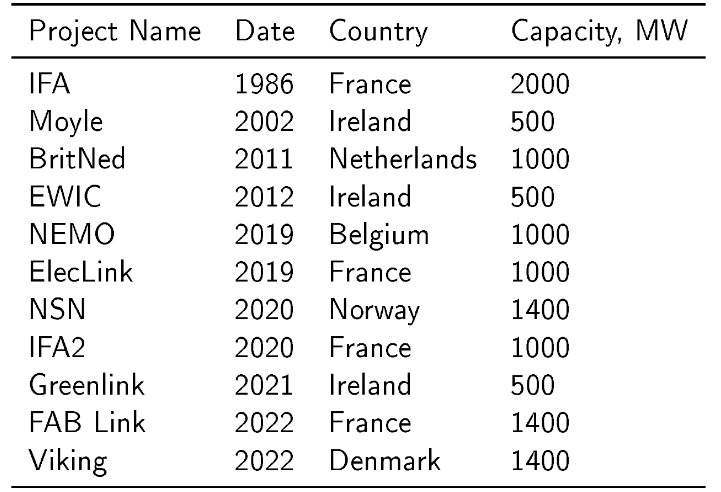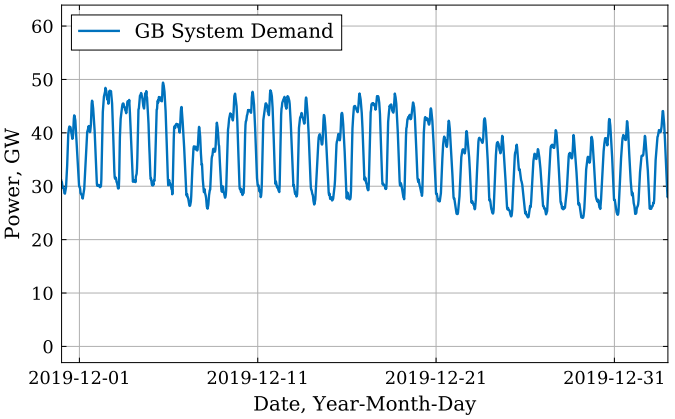Feedback provided to BEIS Panel of Technical Experts on ‘Modelling de-rating factor ranges for interconnected countries in the capacity market in the 2020 Electricity Capacity Report’
The GB capacity market is designed to ensure that there is enough electrical generating capacity to meet peak demands. Approximately £700 million was allocated in the ‘T-4’ capacity auction in 2020, with the portfolio covering a range of technologies, including renewables, demand side response, and interconnectors. With the total capacity of electrical interconnectors doubling to more than 20% of peak demand in the next five years, they can and do make a substantial contribution to GB system security.
Determining a monetary value for the security contribution of interconnectors is difficult compared to that of either conventional or renewable capacity, as interconnectors can both increase and reduce system demands. Earlier this month, the Supergen Energy Network (SEN) Hub responded to a call for feedback from the Electricity Market Reform (EMR) Delivery Body on the methodology for calculating interconnector de-rating factors (a link to our response). The call is of interest to the SEN hub as it lies at the intersection of network operation with ‘Markets and Regulation’ and ‘Risk and Reliability’ work packages.

Table 1: Total interconnector capacity is projected to increase from 4 GW at the start of 2019 to more than 11 GW by the end of 2022. Source: OFGEM
What is the GB Capacity Market for?
The UK Government’s EMR reforms of 2013 attempts to solve the ‘missing money’ problem in medium term planning of power systems. The problem states that energy-only markets fail to incentivise the building of generation due to the marginal cost of energy (in £/MWh) being too low when the system margin is tight. The EMR introduced a number of reforms to incentivise the investment in capacity required to meet system peaks, one of which was the GB capacity market.

Figure 1: GB half-hourly transmission system demand for December 2019. As well as providing energy, interconnectors provide value by being responsive to peaks when they occur.
For conventional generators (such as nuclear or gas), the method of calculating the capacity market value of a generator is relatively straightforward. Historic data from forced outages (periods where plant is unable to supply power due to unexpected equipment failure) are collected; from this, an overall de-rating factor is calculated based on the likelihood of a generator being unavailable during a system peak. A similar method can be used for renewable generators, based on the coincidence of meteorological patterns and demand. Generators are then paid in proportion to their de-rating factor.
How are the Interconnectors accounted for in the analysis?
Interconnectors are treated in a similar way in the calculation of their contribution to security, using de-rating factors. However, interconnectors are generally more complex than generators, with power flows largely driven by price differentials. For example, nuclear power on the French system tends to be inexpensive compared to gas turbines that are common in the GB system, and so the GB system frequently imports through the French interconnector. On the other hand, if the energy price is higher on the French system (perhaps due to unforeseen nuclear generation outages) then the interconnector is likely to export to France, potentially reducing security.
The EMR Delivery Body models the countries to which the GB system is connected using an ‘economic dispatch model’. Prices during system stress events are estimated and the resulting flows used to determine interconnector de-rating factors. The model uses many decades of weather data, allowing the impact of increasing penetrations of renewables in future years to be factored in.
The estimation of de-rating factors for interconnectors across many countries years into the future makes for a very challenging modelling task. Whilst the approach used by the EMR Delivery Body has only been presented at a high level (i.e., with few technical details), there were two issues which we identified and highlighted in our response. These points were based on a combination of our understanding of these high-level details (as described here) and the published capacity market rules.
What was our feedback?
We considered their approach using the principle of parsimony: a model should be as concise as possible, whilst still being able to explain all significant phenomenon. Implicitly, this requires a judgement of what constitutes the main ‘thing’ that a model is trying to predict or explain.
It follows, therefore, that the method should be validated against the model out-turn (the ‘reality’ the model is predicting). In this case, the out-turn is the expected flows of interconnectors during formal system stress events up to five years in the future. Only a validation against an approximation of this reality is likely to be meaningful, not least because there is yet to be a formal system stress event, but also because there are many exogenous factors (e.g. transmission constraints) which can have a significant impact on resultant power flows.
This point is particularly relevant as, until last year, the capacity market rules stated that the economic dispatch model should be compared against an historic benchmark. There are several reasons as to why this hindcast-based approach is not advisable – for example, the generating fleet in countries such as Germany is due to change significantly in the next five years. However, it is our view that the outputs of a model should still be validated publicly, with decision makers made aware of the method of validation and the results. The validation could be, for example, against periods of high Loss of Load Probability (LOLP), or some other indicator of system stress.
The second point we raise is on a similar topic. If you do compare historic interconnectors flows against the LOLP, it appears to be the case that some countries tend to export when the LOLP is high, whilst others tend to import. (Exports during stress periods could occur, for example, if two countries have highly correlated peak demands.) As a result, some interconnectors may in fact be tending to diminish the system security, even if most interconnectors are improving security. The capacity market rules do not explain how this effect could be taken into account in the analysis. Our judgement is that this is a major part of the ‘reality’ of interconnectors, which should therefore be recognised by the method.
What is the future for interconnectors within the GB system?
Generally, it is known that interconnectors provide huge benefits to the GB system. Social welfare benefits of interconnectors are measured in hundreds of millions of pounds per year, with strong evidence of positive impacts in terms of reduced system carbon intensity and increased network resilience. It is important, however, for methods of remuneration within the capacity market be made robust, so that decision makers and investors can be fully informed as to their value within the system, both today and in the future.
Read our response submitted to BEIS’ Panel of Technical Experts (PTE)
Author Bio

Dr Matthew Deakin is a postdoctoral research associate with the Supergen Energy Networks Hub at Newcastle University. His research interests include whole energy systems analysis, power system planning and operations, and smart grids.
Additional contributions to this post were made by Sarah Sheehy (Durham University), Dr David Greenwood (Newcastle University), Prof. Furong Li (University of Bath), Dr Robin Preece (University of Manchester), Dr Sara Walker and Prof. Phil Taylor (Newcastle University).